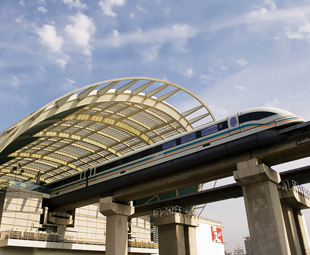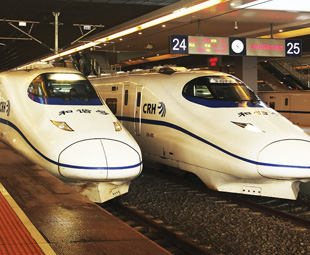Asian transport: birth of the Iron Silk Road

In a move that is changing East-West trade balances, Asian countries are not only upgrading and expanding the ancient Silk Road for internal trade, but also to speed up trade with the rest of the world − including Africa, writes UDO RYPSTRA.
In 1271, a 17-year-old Italian youngster named Marco Polo, set off with his father, rich Venetian merchant Niccolò, and uncle Maffeo, from Italy via Constantinople on a series of adventures that helped put Asia on international maps in a big way.
They travelled by camel, horse and cart, by junk and sailing ship, covering almost 24 140 km on their epic journey. More than a lot of truck drivers do nowadays. The group deviated from routes as they fancied, and only returned to Venice via sailing ship, skirting India in 1295, 24 years later.
Actually, they travelled along what some historians call the Silk Road or Silk Routes, an extensive, interconnected network of trade routes across the Asian continent connecting east, south, and western Asia with the Mediterranean world, as well as north and north-east Africa and Europe. Most of these routes were little more than camel tracks.
On his return, Marco was thrown in jail during the Venetian war with Genoa and during his incarceration, he dictated his Asian experiences to an inmate which was published and translated into most European languages. The Travels of Marco Polo gave Europeans their first comprehensive insight into Asian customs and also the Far East, including China, India, and Japan.
The book described paper money and the burning of coal (which the Chinese, as we know, still can’t get enough of today). While there is no mention of the Great Wall, nor the region of North Asia known as Siberia, it does refer in detail to the riches and treasures they found to the south, and were laden with on their return home.
The Silk Road gets its name from the lucrative Chinese silk trade, which began during the Han Dynasty (206 BCE to 220 CE), and was a major reason for constructing the extensive trans-continental trade routes network. Extending along 4 000 miles (6 500 km), the routes enabled people to transport goods, slaves and luxuries such as silk, satin, hemp and other fabrics, musk, perfumes, spices, medicines, jewels, glassware and even rhubarb. The Silk Routes also served as a conduit for the spread of knowledge, ideas, cultures, zoological specimens and some non-indigenous diseases between ancient China, ancient India (Indus valley, now Pakistan), Asia Minor and the Mediterranean.
Trade on the Silk Road was a significant factor in the development of the great civilisations of China, India, Egypt, Persia and Rome, and also helped in several respects to lay the foundations for the modern world.
The book set the imagination whirling and facilitated the increased trade between the East and West, with Arabian traders acting as middlemen exchanging European goods for Asian goods (no empty camel legs here!)
Trade flourished until the Crusader Wars, when the European scramble began for alternative routes to cut out the middlemen. Christopher Columbus is recorded to have owned a copy (replete with his own anecdotes) of Marco Polo’s book when he set out for the Far East some 200 years later, but subsequently discovered America instead when he went the wrong way.
 Sadly, it also led to the European colonisation of many parts of Asia, and also to the Spice Wars in which Eastern populations were annihilated and one-way trade or virtual plundering was standard, with European countries being the beneficiaries.
Sadly, it also led to the European colonisation of many parts of Asia, and also to the Spice Wars in which Eastern populations were annihilated and one-way trade or virtual plundering was standard, with European countries being the beneficiaries.
But the scales of trade are now weighed in Asia’s favour. The mainland and island nations belonging to Asia are going through a development phase that has already seen Japan becoming a world economic powerhouse with a top class transport infrastructure to feed it, as well as additional transport demands such as the staging of the World Olympic Games. Asian countries to watch now in terms of trade and transport development are China, India and Korea − all of which have such massive vehicle manufacturing capabilities that they export huge numbers of cars, trucks and buses to neighbouring countries, Africa, and the rest of the world.
Manufacturing in Asia has traditionally been strongest in east and south east Asia, particularly in mainland China, Taiwan, South Korea, Japan, India, Philippines and Singapore. Japan and South Korea continue to dominate in the area of multinational corporations, but increasingly, mainland China and India are making significant inroads. Many companies in Europe, North America, South Korea and Japan, including vehicle manufacturers, have operations in Asia’s developing countries to take advantage of its abundant supply of cheap labour and “relatively” developed infrastructure.
China is now the talk of the global town, having turned into a giant wielding economic power that is frightening the daylights out of American politicians, generals and financial commentators. Already connected by air through many international airlines and having its own large merchant shipping fleet to trade with the rest of the world, it also features integrated transport systems to serve its citizens and tourists, as Beijing did during the Olympics in 2008.
The highway and road system has also undergone rapid expansion, resulting in a sharp increase in motor vehicle use throughout China. Although China’s transport system comprises a vast network of transport nodes across its huge territory, the nodes tend to concentrate in the more economically developed coastal areas and inland cities along major rivers. Non-mechanised transport remains the only alternative the further one travels off the beaten track.
Rail, which is the primary mode of transport in China, has doubled in length since the mid-twentieth century, and an extensive network provides service to the entire nation. The larger cities all have metro systems either in operation, under construction, or in the planning stage. While the rural rail transport infrastructure of China and other Asian countries is still being upgraded, several of China’s inter-city and urban transport systems already compare with the best in the world, featuring a bullet train that clocked a new rail speed world record last month. According to a recent report by state-owned Xinhua News Agency, the train reached a top speed of 486,1 kilometres/hour (302 mph) on the track between Zaozhuang City of Shandong Province and Bengbu City in eastern Anhui Province, part of a new high-speed rail line that will eventually link Beijing and Shanghai.
What will improve rail traffic through many Asian nations is a massive project for which the go-ahead was signed by 17 Asian countries in 2009. This is the Trans-Asian Railway (TAR) line which is expected to provide a 14 080 km (8 750 miles) rail link between Singapore and Istanbul (Constantinople), Turkey, with possible further connections to Europe and Africa. The TAR is a project of the United Nations Economic and Social Commission for Asia and the Pacific (UNESCAP). Already dubbed the Iron Silk Road, it will be different from the original Silk Road, which few traders traversed from end to end, in that it is a continuous route, this being that a large extent of the railway network − including the Trans-Siberian line which connects Moscow to Vladivostok − already exists as part of the Eurasian Land Bridge. But some significant gaps remain.
A big challenge is the difference in rail gauge across Eurasia. While most of Europe, Turkey, Iran, China, and the Koreas use the 1435 mm gauge, known as Standard gauge, Russia and the former Soviet republics use a 1520 mm gauge; Finland use a 1524 mm gauge; most of the railways in India, Pakistan, Bangladesh and Sri Lanka use a 1676 mm gauge, and most of South East Asia has metre-gauge. For the most part the TAR would not change national gauges and mechanised facilities would be built to move shipping containers from train to train at the breaks of gauge.
Today, several Asian trading blocks have been established to promote trade and traffic throughout Asia itself, in which both the maritime and overland Silk Routes are again being used, often closely following the ancient routes, but with 4 billion people to feed and provide jobs for, this means finding fuel and commodities to feed its energy plants and factories. Hence their growing trade with Africa and their multi-billion dollar investments in African infrastructure to get these commodities out fast.
At least they haven’t started plundering yet.
Published by
Focus on Transport
focusmagsa



